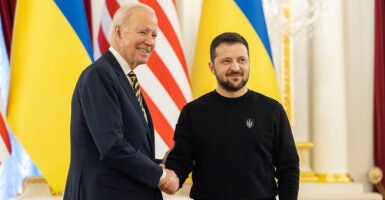The Ukraine mess is daily looking more like the Spanish Civil War of 1936 to 1939, a meat grinder that took 500,000 lives. That three-year conflict became a savage proxy war and prelude for the belligerents of World War II.
Now, a year after Russia’s invasion, the Ukraine battlefield is proving to be a similar laboratory of death. New lethal weaponry and tactics are introduced, modified—and always improved—from drones to guided missiles to internet-fed artillery.
Likewise, a similar pre-global war lineup of the eventual adversaries is emerging in preview of a much larger, much scarier war to come.
The first mission of Ukraine, the aggrieved victim of a peremptory Russian attack, was simple survival.
But now that Ukraine has been armed to the teeth and its soldiers proved far more capable and heroic than Vladimir Putin’s once-feared Russia, Kyiv now seeks to push back the Russians to their 2014 Ukrainian-acquired borders.
Next, Ukrainian President Volodymyr Zelenskyy has announced, the third stage will be to eject every Russian from the 2013 borders of Ukraine. He promises to reabsorb both the Crimea and the Donbas regions.
That is an ambitious goal that might require preemptive attacks inside Russia and on the Black Sea.
To accomplish the last two missions, Zelenskyy needs a blank check of support from a United States that neither can control its own borders nor maintain its critical infrastructure and is $33 trillion in debt.
Americans not only are to supply the money and arms to fuel Zelenskyy’s counteroffensives, but to sign on to a dangerous anti-Russian agenda that isn’t necessarily synonymous with one that is in the best interests of the United States.
As far as Russia goes, Putin knows his attack was a costly mistake. It was predicated on the assumption that an appeasing, doddering President Joe Biden and a U.S. military humiliated in Afghanistan always would remain passive.
Yet Putin still believes that his blunder will not have been a fatal one if he can still destroy much of Eastern Ukraine, institutionalize what he gained in 2014, fracture NATO, propagandize the war as an existential cause of saving Mother Russia from a corrupt West, and reconfigure a new alliance with China, Iran, North Korea, and perhaps Turkey and India.
As far as the United States goes, the Biden administration sees America’s interest as largely defined by a proxy war to defang Russia. To paraphrase Defense Secretary Lloyd Austin, America will pour limitless arms into Ukraine to so weaken Russia that it will have to stay within its current borders.
Washington blithely dismisses all of Putin’s existential threats as empty nuclear saber-rattling—on the Pentagon’s assurance that wounded, cornered, and growling tigers always can be assumed to remain predictably docile.
Biden, whose family influence-peddled with Kyiv for a decade, has radically reversed his initial course. No longer is Biden offering a free ride out of Dodge for Zelenskyy or dismissing any worry over a “minor” Russian invasion.
Biden instead now sees saving Ukraine and punishing Russia as his one shot at a redeeming accomplishment for an otherwise failed administration.
The once-pacifist American Left has embraced Ukraine as its “I told you so” proof that Putin was really the monster that it could not find guilty in its various Russian-collusion concoctions and laptop disinformation hoaxes.
The NATO nations are acting uncharacteristically defiant, given the war is on their borders. They rightly fear a victorious Putin would be vengeful and not satiated.
Yet their “you go first” shipment of hodgepodge weapons to Ukraine, as well as their embarrassment over their past suicidal energy polices and slow-motion disarmament, remind us that Europeans in NATO before the war could not keep the Russians out, the Americans in, or the Germans down.
China believes it can be the real winner of this war. Its rivals and enemies are weakened the longer the war continues. The West is depleting its arsenals. It is tiring of the cost. Rival Russia is bleeding, selling Beijing cheap oil and begging for its weapons.
Neither Europe nor America, China believes, will want to repeat another proxy war—say, one over Taiwan—against a nuclear power with far more leverage over the West and far greater wherewithal on the battlefield.
Iran is selling drones to Russia. Tehran expects a desperate Putin to sell it all the enriched uranium it needs, prevent a preemptive strike on Tehran, and end Moscow’s Syrian wink-and-nod policy with Israel.
India, like Turkey, likes newfound cheap Russian oil. It feels a proximate Russia and China are better entertained than a distant and provocative, but increasingly internally divided and weakened, United States.
Turkey suddenly is booming with cheap oil and a big arms appetite from Russia. It feels rich and illiberal China and Russia both fear Turkey’s export of Islamism and seem better allies than the loud-talking but declining West.
North Korea sees only positives in Western distraction in Ukraine. It counts that its nuclear recklessness is seen as a valuable irritant by both Russia and China.
The longer this preview war goes on, the surer will follow the nightmarish main attraction.
(C) 2023 Tribune Content Agency, LLC
The Daily Signal publishes a variety of perspectives. Nothing written here is to be construed as representing the views of The Heritage Foundation.
Have an opinion about this article? To sound off, please email [email protected] and we’ll consider publishing your edited remarks in our regular “We Hear You” feature. Remember to include the url or headline of the article plus your name and town and/or state.































